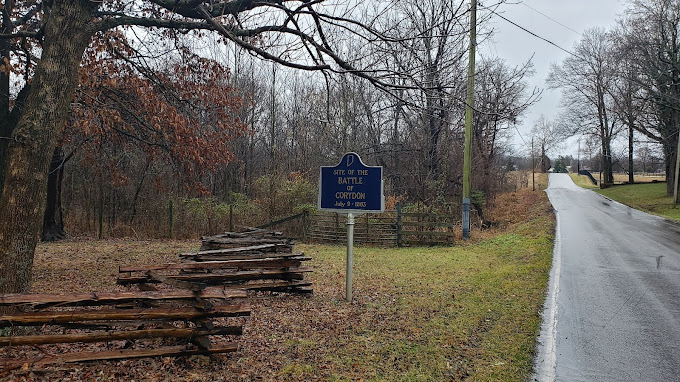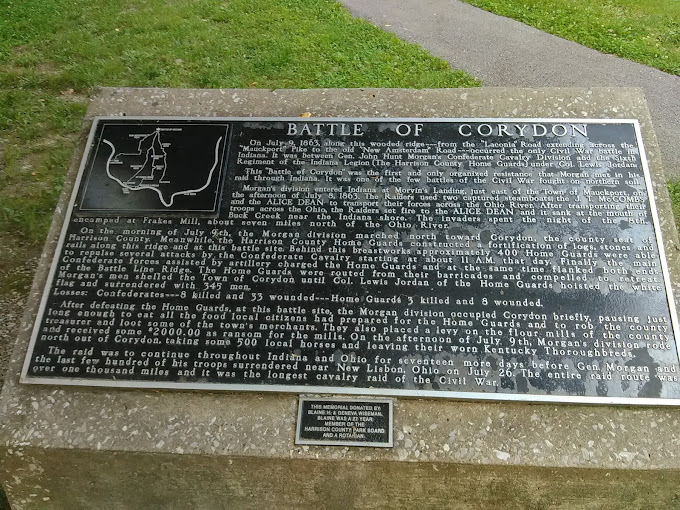ECW Weekender: The Road Less Traveled: Corydon, Indiana

 A friend once said I have a ‘talent’ for sniffing out battlefields. That comment reminded me of George C. Scott, playing General George Patton in the eponymous film: “I can smell a battlefield.”
A friend once said I have a ‘talent’ for sniffing out battlefields. That comment reminded me of George C. Scott, playing General George Patton in the eponymous film: “I can smell a battlefield.”
Unlike Patton–or even the Hollywood version of him–I do not claim any special historical olfaction skills. What I do have is a deep love of history and historical places, no matter how obscure. I was the kid on the family vacation that always read the road atlas, looking for these red “points of interest” features Rand McNally sprinkled across every state. I have always been curious not just about the destination, but also about the things I might find along the way.
Last December, while heading down to Resaca in Georgia, my friend Pat McCormick and I visited Corydon Indiana. I’d been there before, with another friend, about 25 years before, and I wanted to revisit it.
Corydon is an old settlement, at least as midwestern towns go: founded in 1808, it hosted Indiana’s first capitol. It was also the scene of a Civil War battle.
Not a large battle, of course. But local militia did make a stand here, opposing Confederate Brig. Gen. John H. Morgan’s cavalry division. After the raider crossed the Ohio River near Brandenburg Kentucky on July 8, 1863, the next day Morgan continued north towards the county seat of Harrison County—Corydon.
Just south of the town limits, the Rebels were confronted by Indiana Home Guard Col. Louis Jordan and his 6th Regiment of the Indiana Legion, which numbered 400. Though heavily outnumbered, defending behind hastily erected breastworks, the Home Guards mounted a stiff resistance. When Morgan tried to brush them aside with a charge, the Home Guard stood firm. With his first assault repulsed, Morgan sent men to work around the Federal flanks, forcing Jordan to retreat into the village. The action cost Morgan 8 killed and 33 wounded, while the Home Guards suffered 3 dead and 8 wounded.

In town, Morgan’s men proceeded to loot the place, to much Hoosier outrage. One vitriolic Indiana newssheet frothed that “every act of vandalism conceivable was performed by this band of land pirates.” In truth, Morgan’s troopers confiscated supplies and cash, ransomed local industries under threat of destruction, and indulged in a bit of general pillage. While eating lunch in town, Morgan first learned that Lee had been defeated at Gettysburg, which, civilians later claimed, left him “crestfallen.” Then Morgan and his division headed northeast, making for Ohio.[1]
The Battle of Corydon Park is a pleasantly wooded 5-acre site, consisting of a parking lot, a cabin, a cannon, a monument, and some interpretive markers. There is a walking trail and, on certain weekends, the promise of historical interpreters. They have also hosted reenactments, though I have never attended one, either as participant or spectator. While Corydon certainly did not change the outcome of the war, I have been to plenty of sites that were not nearly as well interpreted.
Corydon is only a few miles from Interstates 65 and 64, just west of Louisville, and well worth the Civil War traveler’s time.

[1] “John Morgan’s Raid,” Richmond (IN) Weekly Palladium, July 17, 1863; Lester V. Horwitz, The Longest Raid of the Civil War (Farmcourt Publishing, 2003), 59.


My brother and I visited Corydon almost twenty years ago to see Indiana’s first capitol. We had no idea there had been a battle or skirmish there and I don’t believe the citizens knew much about it, at least those we lunched with. Sorry we were early.